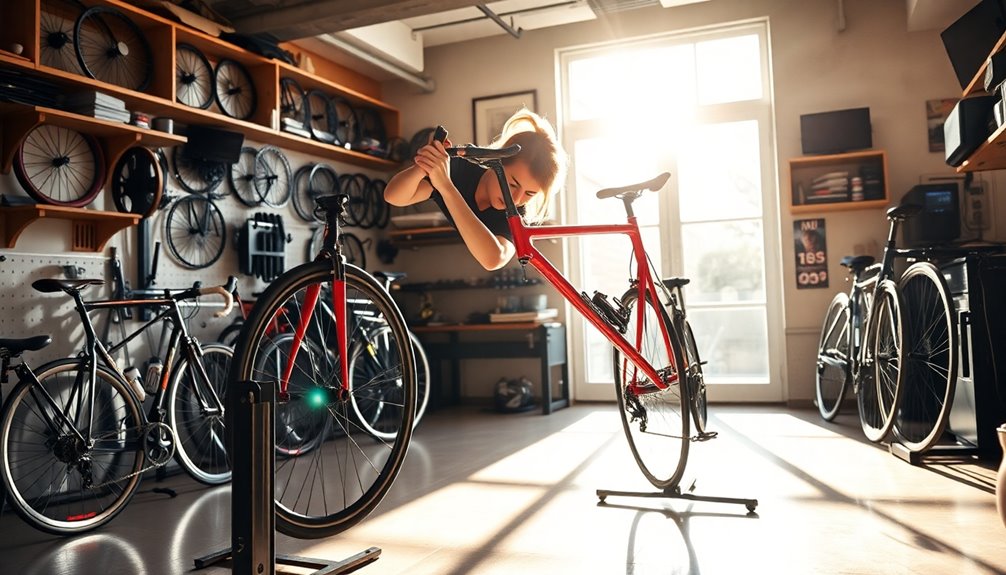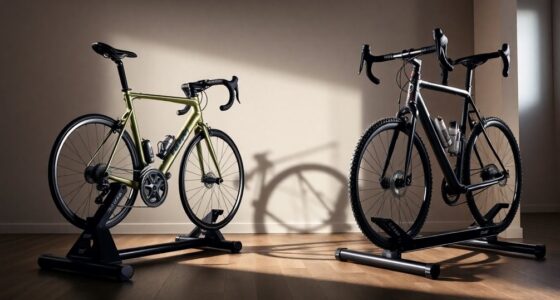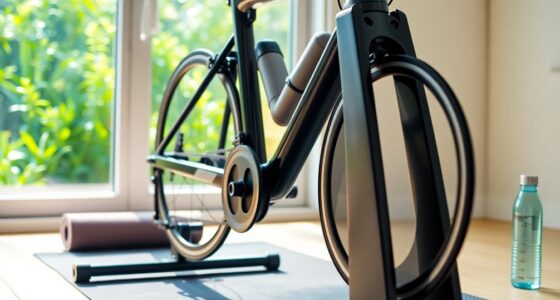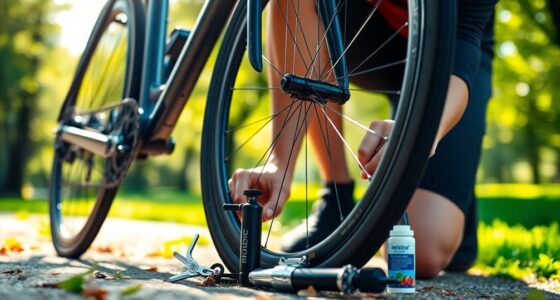Bike fitting's essential for maximizing your comfort and performance on the bike. Start by adjusting your seat height so your knees have a slight bend at the lowest pedal position. Position your handlebars to allow for a straight back and relaxed arms. Don't forget to check grip size for a secure hold. Regularly reassess your fit, especially after injuries or body changes, to keep your rides enjoyable. Discover more tips to guarantee you're always riding your best.
Key Takeaways
- Adjust seat height to allow a slight bend in the knee at the lowest pedal position for optimal leg extension.
- Position the saddle so the knee is directly above the pedal axle for effective power transfer.
- Set handlebar height to align with the saddle or slightly below to promote a comfortable riding posture.
- Regularly reassess bike fit to accommodate body changes and prevent discomfort or injuries during rides.
- Consult a professional bike fitter if persistent discomfort occurs, utilizing advanced tools for accurate assessments.
What Is Bike Fitting?
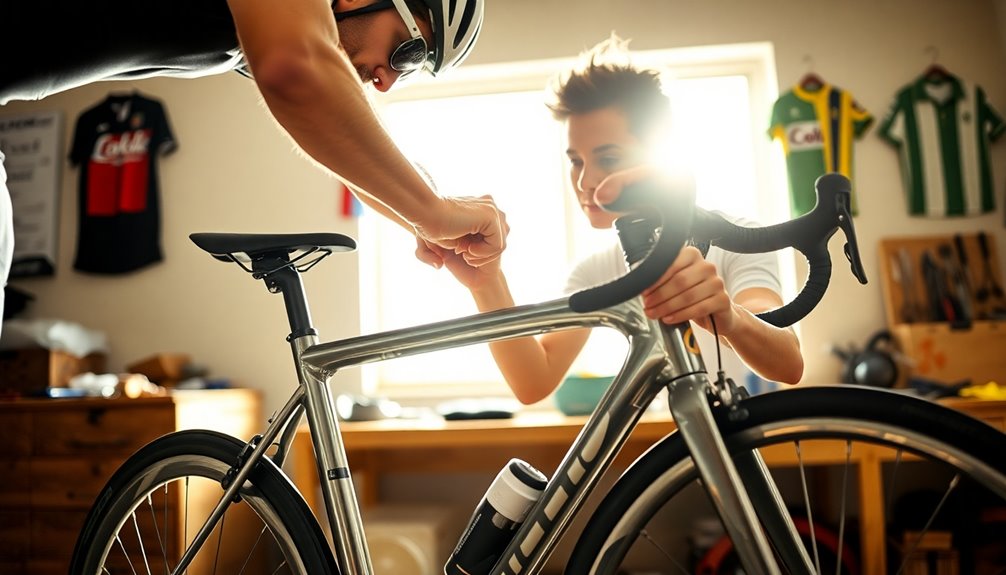
When you think about bike fitting, consider it a professional service designed to enhance your riding experience.
Bike fitters analyze your body proportions and riding style to create a proper bike fit. This process involves adjusting components like seat height, saddle position, and handlebar height, ensuring your bike matches your unique needs.
A proper bike fit eliminates discomfort during rides, such as sore backs or achy knees, while promoting better riding performance.
A well-executed bike fit alleviates discomfort and enhances riding performance, transforming your cycling experience.
Different types of bike fits cater to various needs, from pre-purchase sizing to thorough assessments.
Why Is Bike Fitting Important?
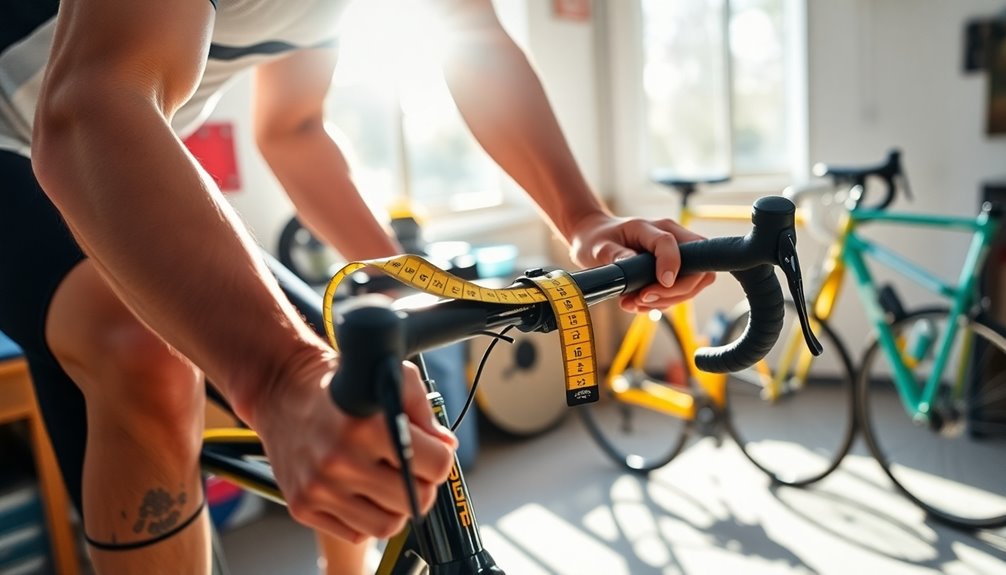
Bike fitting is necessary for any cyclist looking to enhance their riding experience. A proper bike fit session is essential for preventing discomfort and injuries, allowing you to ride efficiently and comfortably for longer.
When your bike is well-fitted, it improves pedaling efficiency, helping you convert your energy into speed. Discomfort during rides, like sore backs or achy knees, often signals a mis-fit, making regular assessments important.
Professional bike fitting experts utilize their knowledge of human anatomy and biomechanics to customize your setup, ensuring it aligns with your unique body mechanics.
Plus, as your body changes due to aging or fitness levels, ongoing evaluations will keep your bike adapted for ideal comfort and performance.
The Basics of Bike Fitting
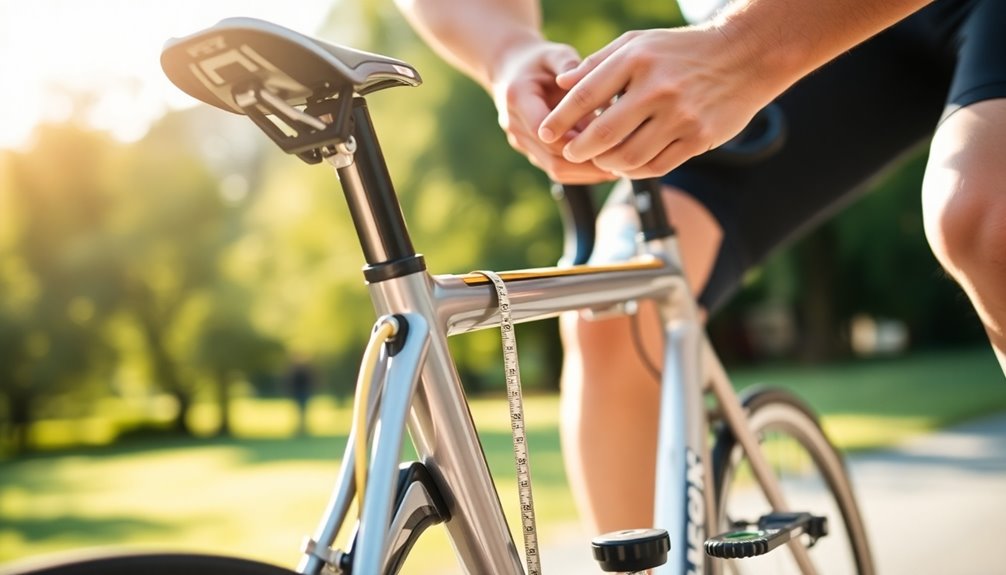
Getting your bike fit right starts with adjusting the seat height and handlebar position.
You want your seat to be at the right height for efficiency, while the handlebars should support a comfortable posture.
Making these adjustments can drastically improve your riding experience.
Seat Height Adjustment
Adjusting your seat height is essential for achieving ideal cycling performance. A proper fit guarantees that there's a slight bend in your knee when the pedal is at the lowest position, enhancing leg extension and power output.
If your seat height is too low or high, you may experience discomfort, such as knee pain or lower back strain. To find your ideal seat height, measure your inseam and multiply that by 0.883 to estimate the correct saddle height from the bottom bracket.
Remember to regularly check and adjust your seat height, as changes in flexibility and cycling style can affect your best fit. Prioritizing a proper fit minimizes fatigue and reduces the risk of overuse injuries.
Handlebar Positioning Techniques
While achieving the right handlebar position might seem straightforward, it plays an essential role in your overall comfort and performance on the bike.
Start by adjusting the handlebar height to align with your saddle or slightly below. This helps maintain a relaxed riding posture, reducing back strain.
Make sure your grip on the handlebars is comfortable; a suitable grip size can greatly lessen hand and arm fatigue. The width of the handlebars should match your shoulder width for better control.
Pay attention to the reach—too far can lead to discomfort in your neck and shoulders.
Finally, fine-tune the position based on your riding style; an upright position promotes comfort, while a more aggressive stance suits racing. Additionally, ensuring that your bike's setup provides color accuracy can enhance your visual experience during rides on varied terrains.
Adjusting Your Seat
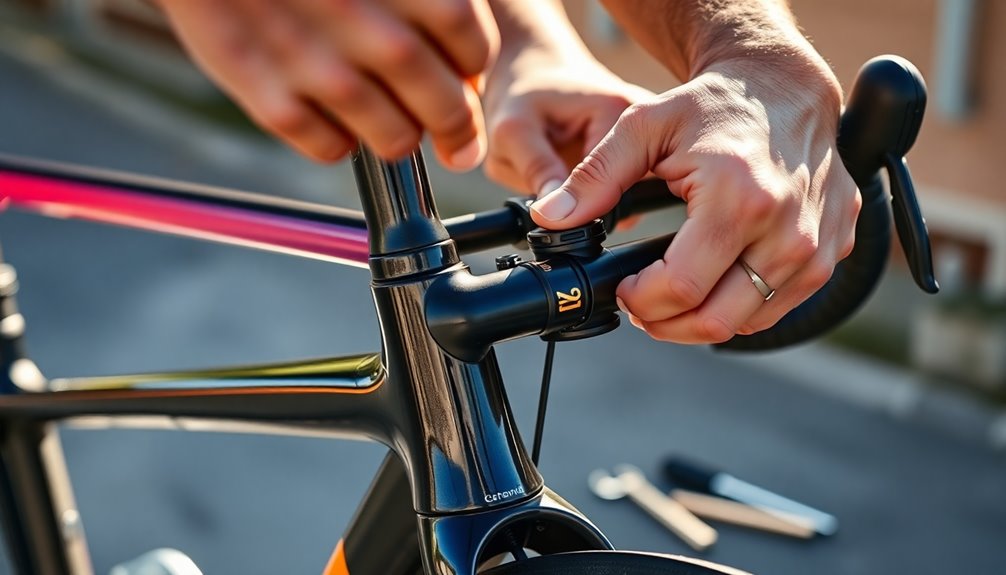
Ensuring your seat is properly adjusted can make a significant difference in your riding experience. Start by setting the saddle height so there's a slight bend in your knee at the lowest pedal position, ideally around 25-30 degrees of leg extension for a comfortable and efficient ride.
Position your saddle horizontally to distribute your weight evenly, enhancing pedaling efficiency. Adjust the saddle forward or backward to keep your knee directly above the pedal axle when the pedal is horizontal.
The saddle's tilt should be nearly level; a slight downward tilt can relieve pressure on sensitive areas. Regularly check these adjustments to your bike, especially after changes in your riding style or fitness level, to maintain ideal comfort and performance.
Handlebar Height and Grip
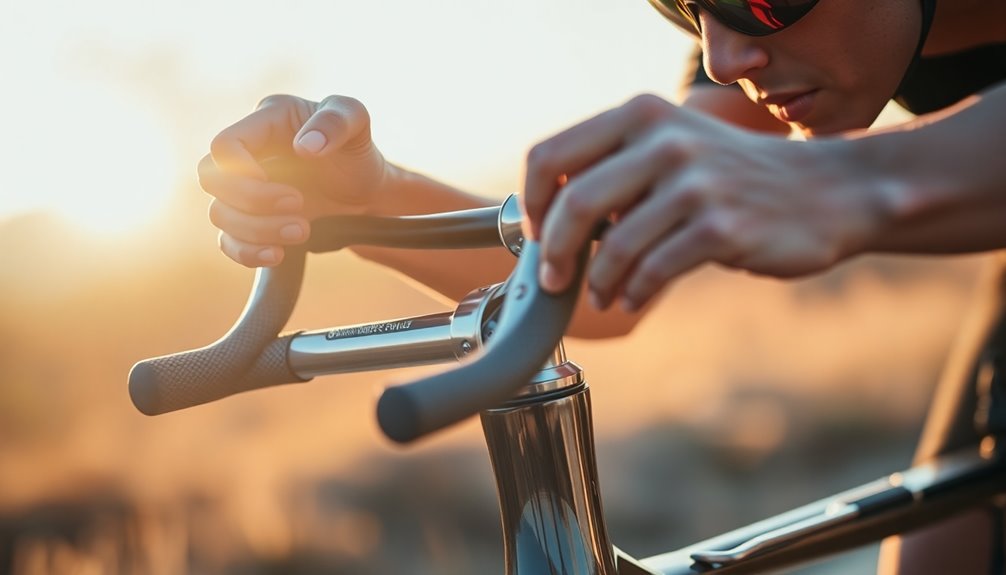
After getting your seat adjusted, it's time to focus on your handlebars for ideal comfort and control. Proper handlebar height allows you to maintain a straight back and slightly bent arms, promoting a comfortable riding posture and reducing strain on your back and shoulders.
Adjusting your handlebars is crucial for maintaining a straight back and comfortable posture, reducing strain on your body while riding.
If you're an endurance cyclist, higher handlebars might be more suitable for comfort, while competitive cyclists often prefer lower handlebars for improved aerodynamics.
Don't forget about grip size; it should fit your hands well to guarantee a secure hold and prevent discomfort or numbness during long rides.
Regularly reassess your handlebar height and grip to accommodate any changes in your body or cycling style, guaranteeing ongoing comfort and performance on every ride.
Physical Therapy and Bike Fitting

When you think about bike fitting, incorporating physical therapy can considerably enhance your cycling experience.
Physical therapy plays an essential role by evaluating your biomechanics and identifying imbalances that may impact your performance and comfort. Specialized therapists provide personalized guidance on necessary adjustments to optimize your bike fit based on your unique physical evaluations.
Extensive bike fitting services often include a physical therapy evaluation to accommodate your body mechanics for injury prevention and performance enhancement.
It's important to communicate any discomfort during fitting sessions so therapists can make tailored adjustments. Targeted interventions can address specific issues like pelvic instability or joint range of motion limitations, ultimately leading to a more effective and comfortable bike fit, ensuring you enjoy your rides to the fullest. Additionally, understanding diversification strategies for your training can further improve overall cycling performance.
When to See a Professional
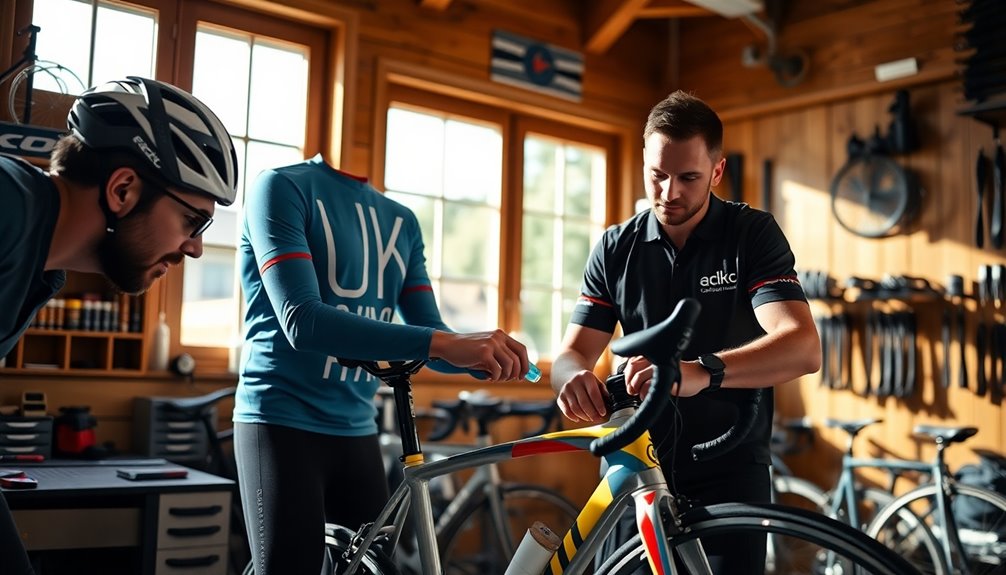
If you're feeling persistent discomfort while riding, it's time to see a professional bike fitter.
They can help with complex fit adjustments that you mightn't be able to tackle on your own.
Plus, if you want to optimize your performance, a fitting tailored to your needs can make all the difference.
Persistent Discomfort Issues
Riding your bike should be an enjoyable experience, but persistent discomfort can turn what should be a pleasure into a painful ordeal.
If you're experiencing ongoing issues like sore backs or achy knees, it's a strong sign that your bike fit isn't right. DIY adjustments mightn't cut it, so seeking professional guidance is vital. A certified bike fitter can assess your biomechanics and help address underlying problems before they escalate into more serious injuries, like pelvic instability or overuse issues.
Regularly reevaluating your bike fit is important, especially after changes in your health or fitness. If you have multiple bikes or just got a new one, professional fitting guarantees each setup suits your unique body mechanics, keeping discomfort at bay.
Complex Fit Adjustments
Complex fit adjustments require a keen eye and expert knowledge to tackle issues like pelvic instability or limited joint range of motion.
If you're experiencing persistent discomfort or pain during rides, despite basic adjustments, it's time to seek a professional evaluation. A certified bike fitter can identify underlying biomechanical imbalances that standard tweaks might miss.
They utilize advanced tools and techniques, such as motion capture and goniometers, to guarantee your bike fit needs are accurately assessed.
Regular reevaluations are essential, especially after changes in health, fitness, or injury history, as these factors can shift your fit requirements.
Customized interventions from a professional can greatly enhance your cycling performance and comfort, addressing issues that DIY solutions simply can't resolve.
Performance Optimization Needs
Persistent discomfort during rides often signals the need for a professional bike fitting. Ignoring this can lead to injuries, making it essential to identify and address fit issues.
Consider seeking a professional if you notice:
- Pain in your back, knees, or wrists
- Changes in your fitness level or cycling goals
- Acquiring a new bike or modifying your setup
- A decrease in performance or comfort during rides
- Regular discomfort that persists over time
Professional fitters use advanced tools to assess your riding position and biomechanics, ensuring you achieve ideal performance and comfort.
Don't hesitate to consult a professional; your cycling experience will greatly improve with the right adjustments tailored to your unique proportions and riding style.
DIY Bike Fit Tips

Achieving the perfect bike fit can greatly enhance your comfort and performance on two wheels. Start by adjusting your saddle height so there's a slight bend in your knee at the lowest pedal stroke. Next, verify your handlebar height promotes a straight back and slightly bent arms. Proper cleat positioning is key for power transfer; try different angles to see what works best for you. Regularly check your bike fit since changes in your body can affect comfort.
| Adjustment Area | Ideal Positioning | Notes |
|---|---|---|
| Saddle Height | Slight knee bend at lowest pedal | Improves leg efficiency |
| Handlebar Height | Straight back, slightly bent arms | Reduces strain |
| Cleat Positioning | Experiment with angles | Enhances power transfer |
| Regular Checks | Assess every few months | Adjust for body changes |
| Professional Help | Consult if discomfort persists | thorough fitting assessment |
Maintaining Your Bike Fit

As you ride more frequently, maintaining your bike fit becomes essential to guarantee ongoing comfort and performance. Your body changes over time, so it's vital to regularly check and adjust your bike fit.
Here are some tips to help you stay on track:
- Schedule annual evaluations with a professional bike fitter.
- Monitor any discomfort or pain during rides.
- Keep a record of adjustments and their impact on your comfort.
- Regularly inspect saddle and handlebar heights for wear.
- Reassess your bike fit after experiencing injuries or changes in fitness.
Frequently Asked Questions
How Do You Adjust the Comfort on a Bike?
To adjust comfort on your bike, start by setting the seat height so there's a slight bend in your knee when the pedal's at its lowest.
Make sure the saddle is level to evenly distribute your weight.
Adjust the handlebars to a height that allows a relaxed posture, ideally at or just below saddle level.
Finally, check your grip on the handlebars; it should be relaxed to prevent fatigue during longer rides.
Regularly reassess your setup!
What Is the Correct Height for Bike Seat and Handlebars?
Did you know that about 80% of cyclists experience discomfort due to improper bike fit?
To guarantee comfort, your bike seat should allow a slight bend in your knee at the lowest pedal point, typically aligning with your hip.
For handlebars, set them at or slightly below saddle height, allowing for a relaxed grip with slightly bent elbows.
This setup can greatly reduce strain on your back and shoulders, enhancing your ride experience.
What Is the Number 1 Rule for Bicycles?
The number one rule for bicycles is ensuring proper fit. If your bike doesn't fit you well, it can lead to discomfort and even injury.
Adjusting the saddle height, handlebar position, and other elements to match your body proportions is essential. When your bike's fit is right, you'll enjoy a more efficient ride with improved comfort.
Regularly check and adjust your bike to accommodate any changes in your body over time.
What Is the Formula for Bike Fit?
The formula for bike fit involves measuring your inseam, torso, and arm lengths to determine the best saddle height, reach, and handlebar position.
You'll want to set your saddle height so your knees have a slight bend at the lowest pedal point. Align your knee over the pedal axle for ideal weight distribution, and adjust handlebar height according to your riding style.
Regularly reassess your fit, especially after changes in fitness or body shape.
Conclusion
In the end, think of bike fitting like tuning a musical instrument. Just as a guitar needs the right adjustments to produce a beautiful sound, your bike needs to be fine-tuned for comfort and performance. When everything's in harmony, every ride feels effortless, and you can focus on the journey ahead. So, take the time to adjust your bike and enjoy the ride—your body will thank you, and you'll pedal with the ease of a perfectly strummed chord.
